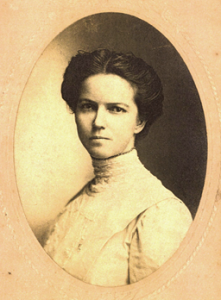December 8, 2021
Dorothea Dix and her efforts to reform Prison and Insane Asylums

Dorothea Lynde Dix was an American reformer who advocated for the improvement of hospitals, prisons, and asylums.1 In 1841, after Dorothea Lynde Dix conducted a small Sunday class at the East Cambridge Jail in Massachusetts, she was given a tour. It was on this tour that Dix witnessed such cruel conditions that inmates endured while in prison. The mentally ill were housed in what was known as “Dungeon Cells.” There were men and women, even children, naked and chained to walls, sleeping on filthy floors, and underfed. Dix’s jail visit marked a turning point in her life.2

In Dix’s early years, she had a strong passion for education. She studied hard and had an intense desire to teach. At the age of fourteen, Dix opened her own school for young children.3 Dix would hardly give herself any time to completely rest due to the fact that she would overwork herself. The large amount of work caused Dix’s depression and tuberculosis to flare up more than usual, causing her to take a permanent leave from teaching.4 In 1835, Dix decided to venture off to England to recover for two years. While resting, Dix was introduced to many social welfare advocates by William Rathbone, a humanitarian and philanthropist. The social welfare advocates, Elizabeth Fry and William Tuke, were involved in prison reform and the aid for the criminally insane.5 Meeting the social advocates influenced Dix and had a great impact on her life.6
Dix traveled back to America and for four years she visited with family and friends. She then got the opportunity to witness the horrible living conditions that the mentally ill were enduring at the East Cambridge Jail in Massachusetts. Dix spent two years in Massachusetts traveling to prisons, jails, poorhouses, and hospitals collecting data about the appalling conditions she observed.7 In 1843, Dix took her findings to the Massachusetts State Legislature. She argued for the mentally ill to be housed in a separate institution rather than being housed with criminals. Due to her argument, conditions at the insane asylum in Worchester improved. Dix continued to survey each of the facilities and took note of her findings. In 1844, Dix took part in constructing the first insane asylum in Trenton, New Jersey.8

In the year 1845, Dix’s “Memorial to the Massachusetts Legislature” was presented to the public and to public figures such as Charles Sumner. Dr. Samuel Gridley Howe presented it and stated, “I proceed, gentlemen, briefly to call your attention to the present state of insane persons confined within the Commonwealth, in cages, closets, cellars, pens; chained, naked, beaten with rods, and lashed into obedience.”9 This address caused a public outcry and gained support from the public figures leading to the reform bill being passed into law. Dix continued her work, seeking out help from those with a higher power to renovate and build facilities for the ill. Throughout the years, Dix spent her time founding new hospitals in Rhode Island, New Jersey, Massachusetts, Pennsylvania, New York, and Canada.10 There were just thirteen mental institutions in the United States and with the help of Dorothea Dix, that number had grown to one-hundred-twenty-three. Not only did Dix help found the mental institutions, but she also played a large part in founding fifteen schools for the “feeble-minded” and training schools for nurses.11

Many had believed that those who were insane were incurable and were not normal people. Dix devoting her life to advocating for reform was because she wanted to make it known that insanity was treatable and that with better conditions, the mentally ill could experience greater outcomes.12 In 1848, Dix had traveled to North Carolina and brought attention to the thousands of mentally ill citizens who were not being treated appropriately. They were either being cared for by family members or were in county jails or poorhouses. She advocated for better treatment and sanctuary. Eventually, $200,000 was raised for the hospital and it was named the Dorothea Dix Hospital.13
Dorothea Dix continued her fight for prison and asylum reform until the very end. Dix did go on to experience other things, such as serving as a nurse in the Civil War. In fact, she was made the Union’s Superintendent of Women Nurses. In 1867, Dix continued her work with the mentally ill until her health took a toll which forced her to stop. In her last few years, Dix resided at the Trenton, New Jersey, State Hospital and lived there until her death on July 17, 1887.14
- “Dorothea Lynde Dix,” in Encyclopedia of World Biography, 2nd ed., vol. 5 (Detroit, MI: Gale, 2004), 32–33. ↵
- Donna Batten, ed., “Dix, Dorothea Lynde,” in Gale Encyclopedia of American Law, 3rd ed., vol. 3 (Detroit, MI: Gale, 2010), 510. ↵
- Sally G. McMillen, “Dix, Dorothea,” in Americans at War, ed. John P. Resch, vol. 2, 1816-1900 (Detroit, MI: Macmillan Reference USA, 2005), 47. ↵
- Donna Batten, ed., “Dix, Dorothea Lynde,” in Gale Encyclopedia of American Law, 3rd ed., vol. 3 (Detroit, MI: Gale, 2010), 510. ↵
- Donna Batten, ed., “Dix, Dorothea Lynde,” in Gale Encyclopedia of American Law, 3rd ed., vol. 3 (Detroit, MI: Gale, 2010), 510. ↵
- Rolando Avila, “Dix, Dorothea (1802–1887),” in Women in American History: A Social, Political, and Cultural Encyclopedia and Document Collection, ed. Peg A. Lamphier and Rosanne Welch, vol. 2, Antebellum America through the Gilded Age (Santa Barbara, CA: ABC-CLIO, 2017), 43. ↵
- “Dorothea Lynde Dix,” in Encyclopedia of World Biography, 2nd ed., vol. 5 (Detroit, MI: Gale, 2004), 32–33. ↵
- Rolando Avila, “Dix, Dorothea (1802–1887),” in Women in American History: A Social, Political, and Cultural Encyclopedia and Document Collection, ed. Peg A. Lamphier and Rosanne Welch, vol. 2, Antebellum America through the Gilded Age (Santa Barbara, CA: ABC-CLIO, 2017), 43–44. ↵
- “Dorothea Lynde Dix,” in Encyclopedia of World Biography, 2nd ed., vol. 5 (Detroit, MI: Gale, 2004), 32–33. ↵
- “Dorothea Lynde Dix,” in Encyclopedia of World Biography, 2nd ed., vol. 5 (Detroit, MI: Gale, 2004), 32–33. ↵
- Donna Batten, ed., “Dix, Dorothea Lynde,” in Gale Encyclopedia of American Law, 3rd ed., vol. 3 (Detroit, MI: Gale, 2010), 511. ↵
- Donna Batten, ed., “Dix, Dorothea Lynde,” in Gale Encyclopedia of American Law, 3rd ed., vol. 3 (Detroit, MI: Gale, 2010), 511. ↵
- Sara Constantakis et al., eds., “Dorothea Dix’s Request for a Hospital for the Insane (Excerpt),” in American Eras: Primary Sources, vol. 4, Reform Era and Eastern U.S. Development, 1815-1850 (Farmington Hills, MI: Gale, 2014), 428. ↵
- Donna Batten, ed., “Dix, Dorothea Lynde,” in Gale Encyclopedia of American Law, 3rd ed., vol. 3 (Detroit, MI: Gale, 2010), 511. ↵
Tags from the story
Dorothea Dix
insane asylums
prison reform
Recent Comments
Alonso Rodriguez
It is spectacular how Dorothea Dix changed the course of psychiatric treatment and ushered in a new way of breaking down the stigmas developed about the mentally ill. It is still a taboo subject in many situations, but thanks to people like her, much progress has been made.
08/12/2021
8:07 am
Serenity Kamenski
Dorothea Dix’s story really shows that although she may had had a passion for education she didn’t stop there. She saw the injustices of how many prisons had treated the mentally ill, and she chose to devote her life to ensuring that those who were suffering got the help they needed. The article itself did a great job in not only giving Dix’s background but also dove into the reasoning surrounding why she wanted to reform prisons and open up insane asylums separately. Your choice of including Dorothea Dix’s struggle with depression and tuberculosis not only painted her in a more empowering light, but drove home the message that mental illness could be overcome.
13/01/2022
8:07 am
Kelly Arevalo
I had not heard about Dorothea Dix before, but after reading this, I admire her. She had an attitude towards the mentally ill ahead of her time. She cared about giving them the minimum of humanity and recognized their needs. They could not be ignored nor punished for something they could control. And, having lived that herself, her empathy is more remarkable. Very interesting!!
20/01/2022
8:07 am
Kanum Parker
Dorothea Dix is a. prime example of making the world a better and more equal of a place. She dedicated her life to improve at that time what most would think criminals and lost causes lives. She knew that even though these people are different they were people to no matter how they were. She gave those who didn’t have a chance a chance at life and a future. We need to think like her on how can we improve life for those less fortunate because many will just be left behind.
26/01/2022
8:07 am
Grace Malacara
I’ve learned briefly about Dorothea Dix and her efforts to reform prison and mental institutions. Her dedication helped spread better knowledge about mental illness, she changed their perceptions of mentally ill individuals. You did a great job of telling her accomplishments, it was a very interesting article. The images used really engaged me in the story as well, overall great article.
30/01/2022
8:07 am
Carlos Hinojosa
Dorothy Dix did a great service for the U.S. for her reform on insane asylums, a once broken people that were treated just like common criminals now had a place to rest. It’s a shame however that after she died the asylums, she once created turned into something twisted. Still, you can’t deny the benefits the asylums brought to both society and the mentally ill. A very well-made article and I hope to read more by you.
05/02/2022
8:07 am
Gabriella Parra
I love the way you started the article. It is definitely attention grabbing. It is amazing that Dix’s efforts happened in the 1800s and we are just now truly being able to destigmatize talking about mental health. This article makes me interested in researching what conditions in mental institutions are like today and how exactly these patients are treated. I feel like mental institutions are often portrayed as dangerous, scary places, but I wonder if it is more fiction than fact.
13/02/2022
8:07 am
Charles Lares
many people who advocate for others will always have my respect. during the mid 1800’s people taught that mental illness was a disease but it really isn’t. People who are in jail or have a mental illness should be treated differently in society because they are people too, sop what makes them different than the rest? I think she did an amazing job in her life because she didn’t see what was superficial, she saw beyond that and saw that they had hearts and souls as well, although still today it still goes on, she did what she could to get the awareness.
13/02/2022
8:07 am
Victorianna Mejia
This article was engaging and had me captivated within a couple of sentences. I loved reading about Dorothea Dix, and how she helped bring attention to those who are mentally ill. I have always wondered what may have been the start of the mental health revolution and I am happy to learn she was part of it. Again, great article and well written!
14/02/2022
8:07 am
Edelmira Lopez
Very interesting.
08/12/2021
8:07 am